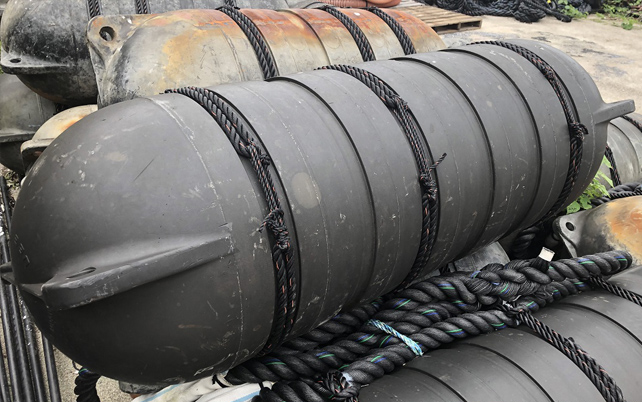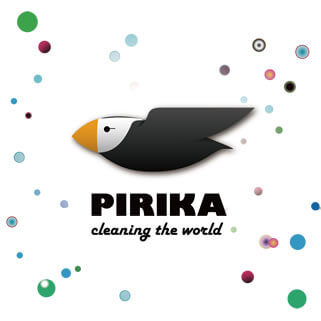At present, some of the sources of marine plastic litter are known to be lost and abandoned fishing gear, which is referred to as "ghost gear," "ALDFG" (Note 1), etc. Through SeaBOS (Note 2), Nissui has joined GGGI (Note 3) and is also making efforts to prevent fishing gear used by fishery companies and aquaculture companies in the Nissui Group in Japan from flowing out into the ocean.
(Note 1): Abandoned, Lost or otherwise Discarded Fishing Gear.
(Note 2): Seafood Business for Ocean Stewardship.
(Note 3): Global Ghost Gear Initiative. An international body working to prevent fishing gear from flowing out into the ocean.
The Nissui Group will manage fishing gear in a thoroughgoing manner not only to prevent fishing gear from flowing out into the ocean but also to help reduce accidents involving the breakage of fishing gear (operation loss, escaped cultured fish and other factors that affect the ecosystem) and work-related accidents.
We are enhancing fishing gear management rules at all aquaculture companies and fishery companies in the Nissui Group in Japan. Our existing fishing gear management rules at the individual company level have been reviewed afresh from the viewpoint of preventing fishing gear from flowing out into the ocean by using GGGI’s “Best Practice Framework for the Management of Fishing Gear” (a guideline for fishing gear management targeting persons involved in fishery business, consisting of prevention, mitigation and remediation) as reference. These fishing gear management rules include equipment condition checks, employee education, appropriate disposal of used fishing gear, and reporting procedures, etc., in the unlikely event that fishing gear has been lost or abandoned.
| FY2021 | FY2022 | FY2023 | ||||
|---|---|---|---|---|---|---|
| Aquaculture companies in the Nissui Group in Japan | Fishery companies in the Nissui Group in Japan | Aquaculture companies in the Nissui Group in Japan | Fishery companies in the Nissui Group in Japan | Aquaculture companies in the Nissui Group in Japan | Fishery companies in the Nissui Group in Japan | |
| Number of educating companies | 6 out of 6 companies | 1 out of 1 company | 6 out of 6 companies | 1 out of 1 company | 5 out of 5 companies | 1 out of 1 company |
| Number of times conducted | 13 times | 2 times | 12 times | 1 times | 20 times | 1 times |
| Total number of participants | 243 persons | 21 persons | 342 persons | 18 persons | 286 persons | 52 persons |
We standardized reporting procedures and matters to be reported in the unlikely event that fishing gear has been lost or abandoned. Within the Group, it is mandatory for the staff at the site of each aquaculture company/fishery company to report such an incident to the company representative, who must then report it to Nissui’s executive officer. Outside the Group, a report must be made to relevant organizations, etc. Matters to be reported are standardized among all companies, including basic information (i.e., when, where, what, how and why), in addition to the recoverability of such fishing gear and preventive measures for the future. In the event of outflow of fishing gear into the ocean, we will strive for thorough reporting and take steps to prevent recurrence.
Report on incidents of fishing gear outflow
Objects washed ashore after a natural disaster (e.g., typhoon) pose a big problem. These include plastics, including fishing gear such as floats, which not only affect the scenery and the coastal environment but are also costly and require a lot of manpower to deal with them. In the event of fishing gear being lost by the Nissui Group in the course of our operations, we will endeavor to retrieve such fishing gear to the best of our ability.
Goal of the Nissui Group
By the end of FY2024, the Nissui Group will cease the use of polystyrene foam floats in nylon covers for use in aquaculture and completely switch over to floats that have a lower risk of becoming plastic that outflows into the ocean.
The Nissui Group is engaged in the farming of salmon and trout outside Japan, and of yellowtail, tuna, coho salmon, mackerel, red sea bream, and others in Japan. Traditionally, mostly polystyrene foam floats wrapped in nylon covers have been used in marine aquaculture operations in Japan (Note 1), but compared to other types of floats, the nylon covers inferior in terms of strength, and there are concerns over the risk that, if they happen to tear, the polystyrene inside them could break apart and outflow into the ocean. Given that problem, in FY2019, we conducted a study on the number of nylon-covered polystyrene foam floats owned and their use by the Group as a whole. Furthermore, we made the decision to cease the use of such floats entirely throughout the Nissui Group by the end of FY2024 and replace them with floats that have a lower risk of outflowing into the ocean. (Note 2) The Group as a whole will continue to study the use of fishery gear with a lower risk of outflowing out into the ocean and to work to address the problem of marine plastic through our businesses.
![[Picture] Floats used in marine aquaculture](/assets/img/site/199/199_309_img-03.jpg)
Floats used in marine aquaculture
![[Picture] Before switchover: Nylon-covered polystyrene foam floats](/assets/img/site/199/199_309_img-04.jpg)
![[Picture] Before switchover: Nylon-covered polystyrene foam floats](/assets/img/site/199/199_309_img-05.jpg)
![[Picture] Before switchover: Nylon-covered polystyrene foam floats](/assets/img/site/199/199_309_img-06.jpg)
Before switchover: Nylon-covered polystyrene foam floats


Post-switchover example: PE-coated polystyrene foam floats
(Note 1): We were able to confirm that the marine aquaculture fisheries of Group companies outside Japan are not using nylon-covered polystyrene foam floats.
(Note 2): PE-coated polystyrene foam floats or hollow resin floats.
Sealord Group Ltd., a Nissui Group company based in New Zealand, is involved in fishing as well as the processing and sale of seafood products. In collaboration with Motueka Nets, also located in New Zealand, Sealord is advancing the recycling of its fishing nets. Traditionally, Sealord disposed of used fishing nets in landfills. These nets, composed of metals and various types of plastics, could not be recycled without proper separation of materials―a process that was highly labor-intensive. Through their partnership, Sealord and Motueka Nets have made it possible to dismantle, sort, and recycle fishing nets.
![[image]Fishing Net Dismantling and Recycling Flow](/assets/img/site/199/199_355_img-01e.svg)
![[Photo] Sealord's nets 1](/assets/img/site/199/199_355_img-02.jpg)
Sealord's nets 1
![[Photo] Sealord's nets 2](/assets/img/site/199/199_355_img-03.jpg)
Sealord's nets 2
“Upcycling” means utilizing waste, items no longer needed and other things that would have otherwise been discarded and transforming them into other products. In fiscal 2021, Nissui worked jointly with the Yamaguchi Prefectural Government, Marukyu Co., Ltd. and TerraCycle Japan on “ONE FOR OCEAN,” a private-public upcycling project utilizing marine plastic litter. This project has been adopted as a model project in the “FY2021 Local Blue Ocean Vision Project” of the Ministry of the Environment. In FY2021, Nissui, together with Yamaguchi Prefecture, Marukyu Co., Ltd. and TerraCycle Japan, launched the public-private upcycling project called “ONE FOR OCEAN” (centered around the utilization of marine plastic waste, “ONE FOR OCEAN” was chosen as a model project for the Ministry of the Environment's “FY2021 Local Blue Ocean Vision” project). A total of 409 people, including prefectural residents, private organizations and companies, participated in the coastal cleanup held as part of the project, collecting 2.9 tons of litter.
![[Figure] Flow of “ONE FOR OCEAN”](/assets/img/site/199/199_420_img-01e.png)
![[Picture] Presentation event](/assets/img/site/199/199_420_img-02.jpg)
![[Picture] Simultaneous cleanup of coastal drift marine debris along the Japan-Korea Strait coastline](/assets/img/site/199/199_420_img-05.jpg)
![[Picture] “ONE FOR OCEAN” poster](/assets/img/site/199/199_420_img-04.jpg)
Marine litter including plastics is said to originate from the land, mainly from the cities but its discharge routes are not known. From fiscal 2018, Nissui has been a supporter of Pirika Inc., which is committed to the Albatross Project that aims to investigate the facts surrounding plastics flowing into the ocean and has commenced concrete approaches in dealing with the problems of the marine environment and the problem of plastics flowing into the ocean, which are directly connected to Nissui’s business.
Details of the Albatross Project which aims to investigate the facts surrounding the problem of plastics flowing into the ocean
Development of research methods: Develop an effective method of research on the flow of plastics into the ocean.
Clarification of the flow mechanism: Study the mechanism of plastics flowing into the ocean (flow routes and flow items) and narrow down the problem.
Study and implementation of measures: Study, prioritize and implement measures to combat the problem of plastics flowing into the ocean.
